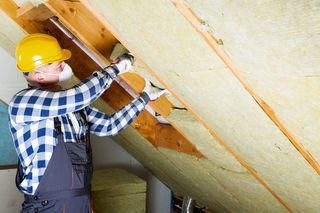What is mineral wool insulation and what are the benefits?
There are plenty of options when it comes to choosing insulation for your home. Here we look at mineral wool and ask an expert to explain all the benefits

Those wanting to know: 'what is mineral wool insulation' have come to the right place. Here we explain what this building material is made from as well as all of its benefits compared to other key insulation choices.
Insulationis of course a hot topic for self builders due to new environmental legislation for building regs, to say nothing of the importance of energy efficiency in the face of sky-high energy costs.
As a result, many homeowners are turning to mineral wool insulation because of its high efficiency and ease of installation. We asked expert Matthew Prowse, from Knauf Insulation and Knauf Insulation’sHousebuilders Hub, to answer common questions about mineral wool for those considering using this insulation type.
矿棉保温材料是什么?
The most common types of mineral wool insulation,which you can buy fairly inexpensively at Wickes, are glass and rock. Glass mineral wool is made primarily from recycled glass, to which is added sand, limestone, and soda ash. Rock mineral wool is primarily made from volcanic rock. This is typically basal and/or dolomite, but an increasing proportion of recycled material from slag and manufacturing off-cuts are now also used.
The raw materials are melted then spun at high speed to form individual strands, to which a binder is applied. This forms a material that is then cured and processed into the final product — a roll or slab of glass mineral wool, or a slab of rock mineral wool.
So how does mineral wool insulation perform in terms of lambda value, U-value and other qualities? Knauf Insulation's expert Matthew Prowse explains that lambda value indicates how easily heat flows through a specific material while a U-value indicates the rate that heat is lost through a building element, like a wall or floor. In theory, lower lambda and U-values, mean less heat is lost but in reality, that isn’t always true.
That’s because some products are easier to install correctly than others, under real-world conditions, says Prowse. For example, if a cavity isn’t perfectly uniform and flat, rigid board insulations like PIR won’t sit flush against it. This can lead to air gaps, which reduce thermal performance. Rigid board insulations also need to be cut to size, with their joints tightly sealed, which allows plenty of opportunity for human error.
By comparison, mineral wool insulation is flexible and adapts to fully fill the cavity, Prowse explains. Where two rolls or slabs meet, they also ‘knit’ together, minimising gaps and maximising thermal performance. Mineral wool insulation is simply easier to ‘get right’.
What are the pros and cons of mineral wool insulation?
When choosing insulation, focusing on just one performance measure could lead to unnecessary compromise. The advantage of mineral wool is that it delivers the bestcombinationof benefits, Prowse explains.
Mineral wool insulation is easier to install correctly, offers real-world thermal and acoustic performance, and is non-combustible* with Euroclass A1 and A2-s1,d0 reaction to fire classifications, so you can use it with confidence for new builds and renovations.
Part L(Conservation of Fuel and Power) of England’s Building Regulations now requires a 31% reduction in operational CO2 and higher fabric efficiency standards for all new homes. And in 2025 the Future Homes Standard will require a 75% CO2 reduction.
Because mineral wool insulation is easier to install correctly, it’s more likely to perform as-designed, helping new homes to comply with energy efficiency standards, Prowse continues. With regulations tightening, many people are also choosing to build with 150mm wall cavities, allowing them more freedom to choose the best insulation for their home.
当谈到safet开火y, it should go without saying that using combustible materials adds unnecessary risk, which just isn’t worth it.
* As set out in changes to the building regulations 2010 which bans the use of combustible materials, limiting use of materials to those achieving A1 or A2-s1,d0 on buildings in scope of the ban (as defined in regulation 7(4..
What is the difference between rock mineral wool and glass mineral wool insulation?
Rock and glass mineral wool insulations behave slightly differently, which can affect the applications they’re best suited to, explains Prowse.
例如,当考虑防火,我们generally recommend glass mineral wool insulation for party walls because fire resistance comes from the building’s structure. But for the separating floor of a loft conversion, we recommend a rock mineral wool product that has been tested to provide 60 minutes of fire protection in this application. That’s because the solution allows for the existing ceiling to be retained and the fire resistance of existing materials is often unknown.
Another slight difference is acoustic performance. Acoustic glass mineral wool is lighter than rock, so can act as an absorption layer in a variety of applications like internal partitions and floors. Rock mineral wool is better for applications like warm flat roofs, where acoustic performance is required alongside compressive strength.
Choosing the correct material will always depend on the application and build-up so seek professional advice wheninsulating a wallbefore deciding.

Matthew is specification and housing director for Knauf Insulation, the UK’s largest supplier of insulation for newbuild homes.
During his twenty-plus years in construction, Matthew has seen in numerous iterations of industry regulations and has first-hand knowledge of what’s required to adapt successfully.
Heading up Knauf Insulation’s specification team, Matthew now supports architects, main contractors, and housebuilders across the UK and Ireland, to achieve compliance in the way that best meets their individual needs.
Get the Homebuilding & Renovating Newsletter
Bring your dream home to life with expert advice, how-to guides and design inspiration, direct to your inbox.
Sam is based in Coventry and has been a news reporter for nearly 20 years. His work has featured in the Mirror, The Sun, MailOnline, the Independent, and news outlets throughout the world. As a copywriter, he has written for clients as diverse as Saint-Gobain, Michelin, Halfords Autocentre, Great British Heating, and Irwin Industrial Tools. During the pandemic, he converted a van into a mini-camper and is currently planning to convert his shed into an office and Star Wars shrine.
Most Popular
Bring your dream home to life with expert advice, how-to guides and design inspiration, direct to your inbox.
Thank you for signing up to Homebuilding. You will receive a verification email shortly.
There was a problem. Please refresh the page and try again.
